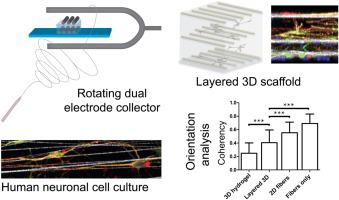Journal of Neuroscience Methods ( IF 3 ) Pub Date : 2020-12-17 , DOI: 10.1016/j.jneumeth.2020.109043 Laura Honkamäki 1 , Tiina Joki 1 , Nikita A Grigoryev 2 , Kalle Levon 2 , Laura Ylä-Outinen 1 , Susanna Narkilahti 1

|
Background
Three-dimensional (3D) in vitro models have been developed into more in vivo resembling structures. In particular, there is a need for human-based models for neuronal tissue engineering (TE). To produce such a model with organized microenvironment for cells in central nervous system (CNS), a 3D layered scaffold composed of hydrogel and cell guiding fibers has been proposed.
New method
Here, we describe a novel method for producing a layered 3D scaffold consisting of electrospun poly (L,D-lactide) fibers embedded into collagen 1 hydrogel to achieve better resemblance of cells’ natural microenvironment for human pluripotent stem cell (hPSC)-derived neurons. The scaffold was constructed via a single layer-by-layer process using an electrospinning technique with a unique collector design.
Results
The method enabled the production of layered 3D cell-containing scaffold in a single process. HPSC-derived neurons were found in all layers of the scaffold and exhibited a typical neuronal phenotype. The guiding fiber layers supported the directed cell growth and extension of the neurites inside the scaffold without additional functionalization.
Comparison with existing methods
Previous methods have required several process steps to construct 3D layer-by-layer scaffolds.
Conclusions
We introduced a method to produce layered 3D scaffolds to mimic the cell guiding cues in CNS by alternating the soft hydrogel matrix and fibrous guidance cues. The produced scaffold successfully enabled the long-term culture of hPSC-derived neuronal cells. This layered 3D scaffold is a useful model for in vitro and in vivo neuronal TE applications.
中文翻译:

生产用于人多能干细胞的神经元细胞的分层3D支架的新方法
背景
三维(3D)体外模型已经发展成为更具体内相似性的结构。特别地,需要用于神经元组织工程(TE)的基于人的模型。为了产生具有针对中枢神经系统(CNS)中的细胞的组织化微环境的模型,已经提出了由水凝胶和细胞引导纤维组成的3D层状支架。
新方法
在这里,我们描述了一种新的生产层状3D支架的方法,该支架由嵌入到胶原蛋白1水凝胶中的电纺聚(L,D-丙交酯)纤维组成,以实现与人类多能干细胞(hPSC)衍生的神经元更好的细胞天然微环境相似性。使用具有独特收集器设计的静电纺丝技术,通过单层工艺构建支架。
结果
该方法使得能够在单个过程中生产分层的含3D细胞的支架。在支架的所有层中都发现了HPSC衍生的神经元,并表现出典型的神经元表型。引导纤维层支持定向细胞生长和支架内神经突的延伸,而无需额外的功能化。
与现有方法的比较
先前的方法需要几个处理步骤来构建逐层3D支架。
结论
我们介绍了一种通过交替使用软水凝胶基质和纤维引导线索来生产分层3D支架以模拟CNS中的细胞引导线索的方法。产生的支架成功地实现了hPSC来源的神经元细胞的长期培养。这种分层的3D支架是体外和体内神经元TE应用的有用模型。



























 京公网安备 11010802027423号
京公网安备 11010802027423号